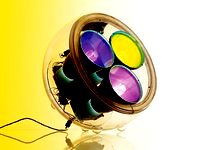Mesopic vision
Intermediate vision between photopic
and scotopic vision.
Metal Halide
A light source that produces light, directly
or indirectly, by an electric discharge through
a gas, a vapour metal or by a mix of different
gases or vapours.
Minimum/average illuminance
In a illumination (lux) or luminance (cd/m2) map,
it is the ratio between the lower and the average
value observed.
Monochromatic radiation
Radiation characterised by a single wavelength.
By extension, radiation characterised by a light
waveband so limited that it can be defined
by the indication of a single wavelength.
Monochromatism
Electromagnetic radiation in which the energy
is concentrated in a single wavelength.
Strictly speaking, monochromatic spectra
are only emitted by lasers, but in reality
those emitted by LEDs are also defined
as monochromatic radiations, even if they
are not exactly so.
Multi lens optic
Optical system made of more lenses,
used to make very precise projections.
MV (Medium Voltage): components (electrified
plates, optional extensions, cables and feeding
kits) with 7-wire cables (Neutral, Direct Line,
Indirect Line, Auxiliary Line, Earth, DALI1 and
DALI2) and 230 VAC feeding tension. If dim-
ming is required, an external DALI circuit com-
plete with DALI power supply, group controller
and scene controller is needed. Used for feeding
and dimming fluorescent lamps, white LEDs,
spot groups and RGB Stand Alone LED versions.
MV (Medium Voltage)
Components (electrified plates, optional exten-
sions, cables and feeding kits) with 7-wire cables
(Neutral, Direct Line, Indirect Line, Auxiliary Line,
Earth, DALI1 and DALI2) and 230 VAC feeding
tension. If dimming is required, an external DALI
circuit complete with DALI power supply, group
controller and scene controller is needed. Used
for feeding and dimming fluorescent lamps,
white LEDs, spot groups and RGB Stand Alone
LED versions.
MWL (My White Light)
See Tunable White.
Neutral white
White colour of a light source with a colour
temperature between 3500 and 5000 Kelvin.
Ohm’s Law
In physics, Ohm’s Law, whose name comes
from the German physicist Georg Simon Ohm,
expresses the constitutive law of proportionality
between the electric potential difference across
a conductor and the intensity of the electric
Planck’s law
Planck’s law is a law of physics devised
by German physicist Max Planck, stating that
the energy associated with electromagnetic
radiation is transmitted in indivisible packets
called quanta, each of which is associated
with a single photon.
PMMA
Acronym for Poly Methyl MethAcrylate, a plastic
material with transparency and appearance
very similar to those of glass; it was initially
marketed by German company Rohm under
the trade name “Plexiglas”. It is widely used
in the automotive sector (rear lamp covers
of cars and motorcycles) and in lighting.
Polycarbonate
Plastic material with excellent properties
of mechanical resistance, especially to bending.
It is used instead of glass or PMMA, where
good impact resistance and good flexibility
are required. It is sensitive to ultraviolet light,
which is why it is often treated with paint
that can filter the rays.
Power
The power is defined as the work (W) per-
formed in a unit of time (t). According to the
principle of equality between work and energy,
power measures the amount of energy
exchanged in the unit of time, in any
transformation process, whether this is
mechanical, electrical, thermal or chemical.
Measured in watts (W).
Power supply
A power supply is an electrical device that
changes the output electrical tension from
AC alternate to DC continuous. The electrical
power can be adapted in this way so that other
electrical equipment can be used. Through a
transformer, the level of output tension and
current, and therefore power, are modified.
Primary optics
Elements that are first intercepted by light
in an optical system.
Profile spot
projector with optic elements able to ‘shape’ the
projection, obtaining a net distinction between
light and dark in the projected light profile.
Projector
Optic device able to transfer lighting energy
from a source to a projection plan. The transfer
can be made replicating the image such as in
cinema projectors (imaging optic) or without
replicating the image such as in the illuminators
(non imaging optic).
Radiant energy
Energy emitted, transferred or received
as radiation. Measured in joules, j = W.S
current passing through it. The constant of pro-
portionality is the electrical resistance. Denoting
the electric potential difference at the terminals
of an electrical conductor with V, and the
electric current passing through it with I, Ohm’s
law states that V = R.I, where R is the electrical
resistance characteristic of the conductor. It is a
constant, regardless of the value of the current.
The current comprises an ordered movement of
electrons, driven by an electric field, which have
kinetic energy. The work done on them by the
field in the unit of time is given by the power.
When the flow of charges passes through
a resistor, part or all of the kinetic energy
of the charges is transferred to the material.
This phenomenon is called the Joule effect, and
the power transferred to the material is given by:
P (W) = V (v) . I (A)
Optics
Part of physics that studies the phenomena
connected with the emission, propagation
and detection of light.
Optical radiation
Electromagnetic radiation having a wavelength
between the X-ray transition region (≈≅1 mm)
and the radio waves transition region (≈≅1 mm).
Passive cooling
System composed of one or more radiators
making sure that a light source (usually LED)
is working at an adequate temperature.
This system is based entirely on the shape
and mass of the radiators.
Photon
From the Greek “Phos, photos” which
means light, the photon or quantum of light
is the elementary particle of energy making up
electromagnetic radiation.
Photometric solid
Spatial representation of the light intensity radiated
by any lighting body
Photometry
from greek FOTOS (light) and METRIA
(measurement). Branch of physics studying the
measurement of photometric values. These are
related to the portion of electromagnetic waves
spectrum that are visible to the human eye.
Photometric values are obtained by radiometric
valuess through integration of the radiometric
spectrum, calculated on the photopic V curve
(lambda) multiplied by 683.
Photopic vision
Vision that occurs when the eye adapts
to luminance levels greater than 3-4 candelas
per square metre. The cones are considered
the main active elements of vision in these
conditions.
O
P
R
N
12 _ 13



































































































































































































































































































































































































































































































































































































































































































































































































































































































































